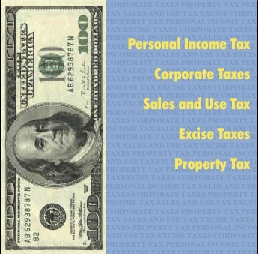
 |
California's Tax SystemA PrimerChapter 4 |
California is one of 48 states to tax corporate profits, and its bank and corporation tax (BCT) is the state's third largest source of General Fund revenues. In 1999-00, it raised an estimated $6.1 billion, or 9 percent of the total. The BCT applies to all corporations which earn income derived from, or that is attributable to, sources in California. Nonprofit corporations (such as churches and charitable organizations) are exempt, as are insurance companies (which instead pay a gross premiums tax).
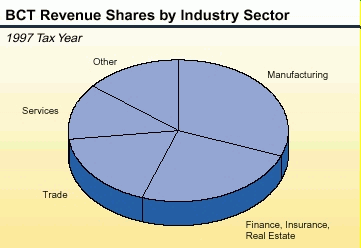
Of the nearly half million corporations filing BCT returns in California, only about 60 percent actually report profits and thus, pay BCT taxes. The remainder report losses, and thus, are subject only to the state's minimum tax. Those firms making profits are distributed among different industry sectors. Manufacturing firms account for almost one-third of all BCT tax liabilities.
The BCT actually encompasses three different individual taxes--the corporate franchise tax, corporate income tax, and bank tax. The corporate franchise tax is paid by most businesses in the state for the privilege of doing business in California, while the corporate income tax is paid by businesses which do not have sufficient presence or activity in the state for franchise tax purposes. The bank tax is paid by banks and financial institutions. All three components of the BCT are assessed based on income, with the franchise tax overwhelmingly dominating--accounting for over 98 percent of BCT revenues.
The BCT's key features include:
| Largest BCT Tax Expenditure Programs | ||
| 2000-01
(In Millions) | ||
| Program | Type of Provision | Revenue Reduction |
| Subchapter S Corporations | Special Filing Status | $1,675 |
| Increased Research and Development Expenses | Credit | 460 |
| Manufacturers' Investment Tax Credit | Credit | 400 |
| Water's-Edge Election | Exclusion/Exemption | 350 |
| Carryforward of Net Operating Losses | Deduction | 320 |
| Tax Exempt Status for Qualifying Corporations | Exclusion/Exemption | 115 |
| Exploration, Development, Research, and Experimental Costs | Deduction | 110 |
| Activities in Economically Depressed Areas | Credit | 108 |
California conforms in a great many BCT areas to federal corporate tax law regarding its basic structure and TEPs. However, some notable exceptions exist. For example, federal law offers more generous depreciation allowances, does not levy an entity-level tax on Subchapter S corporations, and allows 100 percent of NOLs to be "carried forward" as well as to be "carried back" to prior tax years.
Taxation of S Corporations"S corporations" are business entities that receive the limited liability benefits of a corporation, but are taxed like a partnership. That is, their income is "passed through" to shareholders on a pro-rata basis and taxed at each individual's personal income tax rate rather than at the regular corporate rate. In 1998, there were more than 143,000 S corporation returns filed in California, generating $388 million in bank and corporation tax revenues. About one-in-three California corporations are S corporations. Regarding their tax treatment, S corporations:
Most California S corporations are small businesses which also have elected federal Subchapter S corporation status, in that they have no more than 75 shareholders and only one class of stock. However, there also are many very large S corporations in terms of assets, sales, and net income. |
The taxation of corporations doing business only in California is relatively straightforward in terms of computing their taxable profits, in that California profits equal the difference between receipts and allowable deductions (such as expenses for employee salaries). Most businesses filing under the BCT are California-only corporations; however, most corporate income--almost 75 percent--accrues to multistate and multinational corporations.
For these firms, California profits are determined by apportioning a share of their total domestic or worldwide business income to California, based on California's weighted share of their total property, payroll, and sales (in most cases, the sales factor is double-weighted in doing this calculation). International corporations are given the option of using a domestic or worldwide base in doing their apportioning. In contrast to business income's treatment, nonbusiness corporate income, such as interest, is "sourced" to different states and nations using a set of prescribed rules.
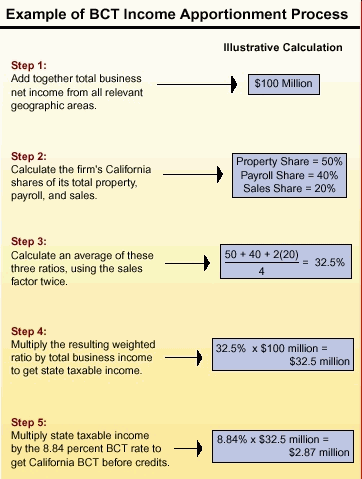
In 1998, over 97 percent of BCT filers had taxable income of less than $500,000. The tax revenues generated by these firms accounted for about 15 percent of the total BCT taxes paid. Corporations earning a taxable income of $500,000 or more, in contrast, represented only 3 percent of returns, but had 85 percent of the tax liability.
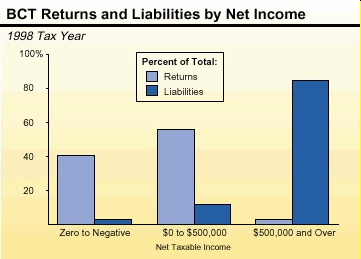
California's basic BCT rate of 8.84 percent is relatively high compared to other states (see accompanying figure). However, in making interstate tax-burden comparisons, one also must take account of more than just the tax rate--such as the various TEPs taxpayers benefit from. One way to adjust for this is by looking at corporate income taxes relative to personal income. In this regard, California's BCT burden is a bit above average for the U.S. as a whole (0.7 percent versus 0.5 percent).
| Comparison of Key BCT Provisions | |||
| 1999 Tax Year | |||
| State | Tax Rate (%) | General Minimum Tax ($) | S Corporation Taxability |
| Pennsylvania | 9.99% | -- | Exempt |
| Massachusetts | 9.50 | $456 | Exempt |
| New Jersey | 9.00 | 250 | Taxable |
| California | 8.84 | 800 | Taxable |
| New York | 8.50 | 100 - 1,500 | Taxable |
| Arizona | 8.00 | 50 | Exempt |
| Wisconsin | 7.90 | -- | Exempt |
| North Carolina | 7.50 | -- | Exempt |
| Oregon | 6.60 | 10 | Exempt |
| Ohio |
5.10 - 8.50 |
50 | Exempt |
| Utah | 5.00 | 100 | Exempt |
| Illinois | 4.80 | -- | Taxable |
| Michigan | 2.20 | -- | Taxable |
The BCT's relatively subdued growth performance in California throughout much of the 1990s also occurred nationally and raises questions regarding the BCT's future role as a major revenue source. While BCT growth occurred in the most recent two years, its flatness in prior years during which the economy performed well remains a concern. For example, between 1994-95 and 1998-99 BCT revenues were basically stagnant even though overall economic growth was strong. This pattern is not fully understood, but some tax experts have pointed to increased use of creative corporate accounting and tax shelters--activities that could continue to constrain growth in the future.
Future BCT growth also could be affected by the substantial overhang of previously generated, but as yet unclaimed NOLs. Although the magnitude of NOLs has declined recently, they still total almost $70 billion, and are worth a potential tax savings of approximately $6 billion to California corporations (and thus, revenue losses to the state), if and when used.
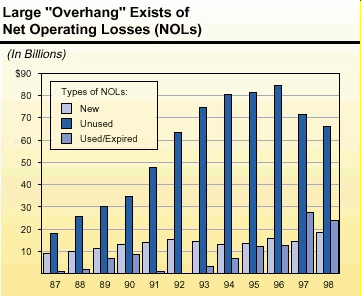
Key BCT issues involve:
Return to California's Tax System--A Primer Table of Contents